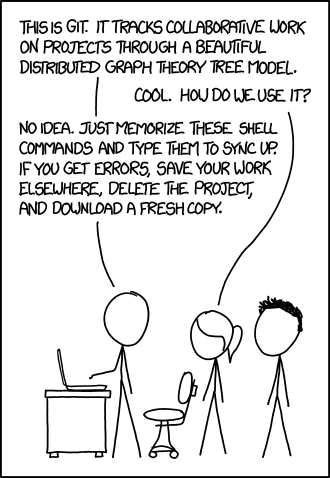You can read this post on Medium here.
I recently released the 1.0 version of QuietTime, my first 'serious' app.
This naturally taught me a few things. I’m going to record those things here because it might be interesting to read — to myself, if nobody else.
Not being (as) scared of Git
I used to think I was comfortable using Git, when in reality I was like the hapless people in this XKCD:

More precisely, I had X major faults in how I used Git.
-
I didn’t care about a clean history.
-
I was too scared to use rebases.
-
I was stingy with branches.
My workflow on previous projects and the first half of QuietTime was to keep a set of long-running branches active at all times for sections of work — one branch for UI work, one for writing tests, one for improving the backend, etc.
This worked, but led to messy merge conflicts every few weeks where I had to laboriously find bad commits, recreate entire branches or or simply throw work away because I wasn’t sure how to handle all the errors.
As a result, the project’s history was full of noise: merge commits, tiny commits, reverse commits.
Thankfully, this suffering led me to bite the bullet and finally understand git rebase -i.
Now that I understand the basic workflow of 'create branch → commit regularly → squash commits → rebase → checkout → merge/fast-forward', life is much, much easier.
Lesson: don’t be afraid of learning the tools you use regularly.
I shouldn’t want everything that I want
For most of QuietTime’s development I was obsessed with the idea that the UI’s text should scale with the size of the window.
Like all dangerously bad ideas, it holds a kernel of a good idea inside itself.
The whole idea of WPF, after all, is that your UI is reactive and can scale, right? Why wouldn’t that include text?
While there weren’t many resources online for this, there were — regrettably — enough for me to hack together a working solution.
For those experienced with WPF, this meant stuffing every Label in the program inside a ViewBox.
The result was ugly and bad for performance, but because I was set on the idea of scaling text, I thought I had to live with it.
Mercifully, when I asked a developer community on Discord for advice, people quickly told me what I was doing was a bad idea from the root.
This led me to fundamentally redesign the app, using more images throughout the UI to avoid the issue altogether.
Lesson: if you’re stuck on something and there aren’t any good resources for it, maybe you’re heading in the wrong direction.
CI/CD is cool, but frustrating to set up
When I started QuietTime, CI/CD seemed like witchcraft. The ability to compile, test, publish and deploy an app from a single commit seemed too good to be true.
For QuietTime, where I wanted to do everything 'the right way', I resolved to figure out CI/CD once and for all.
The result was failure.
My experiments centered around Github Actions for its convenience — nothing to set up except a .yaml file in the project root.
I quickly learned the downside to CI/CD, however: testing your scripts.
My goal was to publish a binary blob of QuietTime whenever I pushed to a 'release' branch, automatically create a GitHub release, and attach a .zip of the blob to that.
While I was happy to find that there were pre-written packages for each of these steps, getting them to work in unison was a holy terror.
Every time I made a change, I had to make a commit, push it to Github, then wait up to five minutes for the test run to succeed (or more likely) fail.
The time investment each change represented quickly made the entire process frustrating beyond belief.
While I eventually got a system halfway working, I learned soon afterwards that I’d hit GitHub’s upload cap through my repeated tests (as I was uploading a binary blob on each one).
In the end, I threw in the towel and simply released QuietTime manually.
Lesson: study file formats and language syntax for CI/CD platforms extensively before trying to use them. Also, crib from known-good examples more liberally.